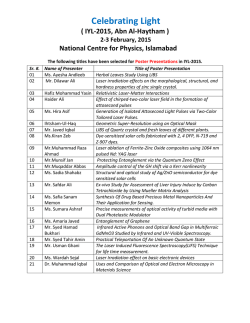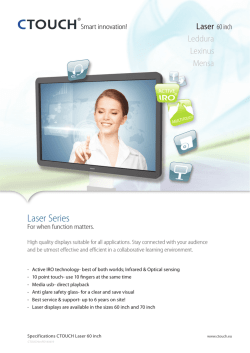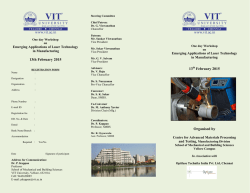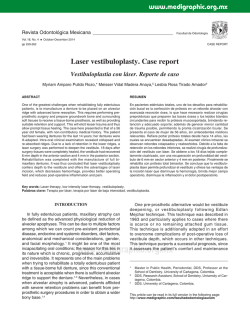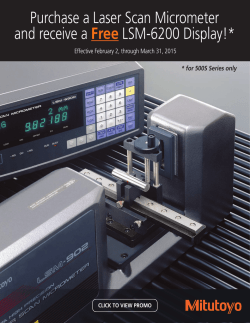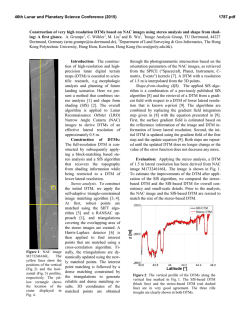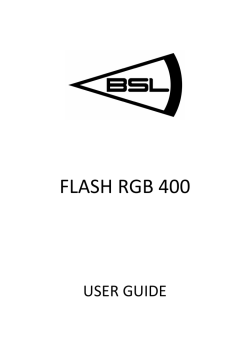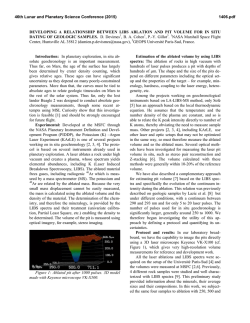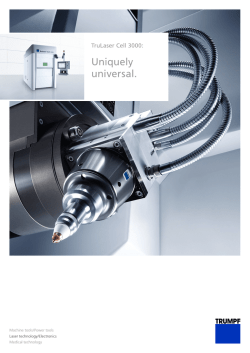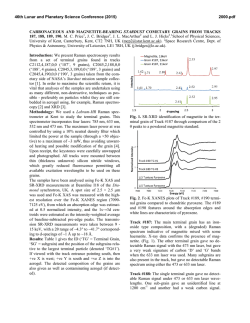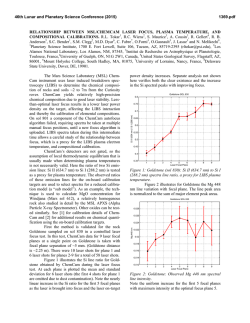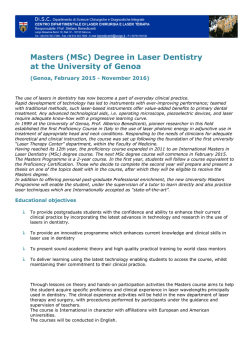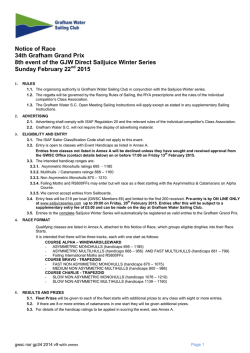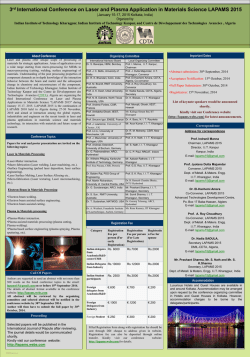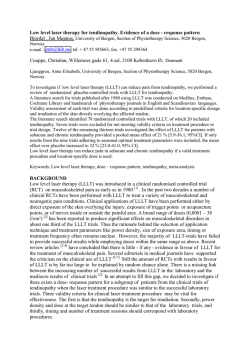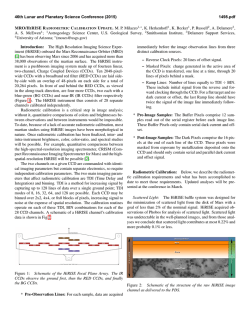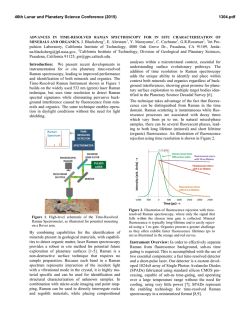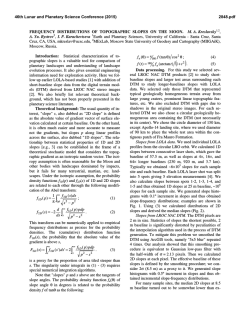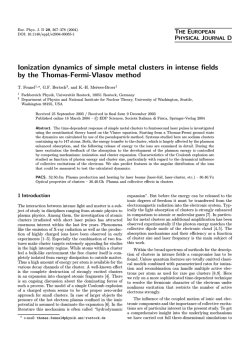
A NEW TOOL FOR CONTROLLING STEREO PAIRS TO LASER
46th Lunar and Planetary Science Conference (2015) 2373.pdf AUTOTRIANGULATION: A NEW TOOL FOR CONTROLLING STEREO PAIRS TO LASER ALTIMETRY Aaron Kilgallon1 , Jon Stephens1 , Sarah Sutton1 and Joel Mueting1 . 1 Lunar and Planetary Laboratory, University of Arizona, Tucson, Arizona 85721 USA; [email protected] Introduction: Currently operating orbital cameras, such as the High Resolution Imaging Science Experiment (HiRISE) [1] and Context Camera (CTX) [2] on the Mars Reconnaissance Orbiter (MRO), and the Lunar Reconnaissance Orbiter Camera - Narrow Angle Camera (LROC NAC) [3], are returning stereo images that are being used to make Digital Terrain Models (DTMs). The process used by many groups (e.g. [4, 5, 6]) incorporates a combination of the Integrated Software for Imagers and Spectrometers (ISIS, http://isis.astrogeology.usgs.gov) and SOCET SET ( c BAE Systems, Inc.) software, after the method described in [7]. The images are pre-processed in ISIS, and then controlled in SOCET SET’s interactive interface, Multi-Sensor Triangulation (MST). This process involves matching the image data to a set of laser altimetry data from either the Mars Orbiter Laser Altimeter (MOLA) [8], for HiRISE or CTX, or Lunar Orbiter Laser Altimeter (LOLA) [9] for LROC. To do this manually requires a skilled operator, time, and a certain degree of subjectivity. To reduce the ambiguity of the process, and to quickly quantify errors, we developed autoTriangulation, a standalone program that takes the DTM and the laser altimetry and finds a best fit between the two. The output of autoTriangulation includes updated ground point coordinates which can then be used to adjust the solution within SOCET SET. autoTriangulation speeds up DTM production, provides consistent solutions, and reduces the extensive training time required for producers. We will make autoTriangulation freely available to the community as a tool in DTM production. Inputs and Parameters: autoTriangulation runs on the Windows command line interface. In its primary mode, the program expects three input arguments, in any order: a geotiff (exported DTM from SOCET SET), the laser track file (in .csv, .tab, or .dbf format), and the MST report file (.rep) from SOCET SET. Further parameters may be specified after these files. Entering no arguments will display the program help documentation. There are a number of parameters that can be adjusted such as: the number of iterations, whether the project is a HiRISE or LROC project (error mapping and the solution parameters are handled slightly differently), whether orbits are to be excluded from the laser data, selection of a linear or a quadratic fit with respect to the laser data, as well as several statistical filtering and convergence parameters. Command line options are detailed in Table 1. The current version of autoTriangulation works only with projects in equirectangular coordinate systems. Future updates will handle polar projects. Algorithm: autoTriangulation applies iterative, least-squares minimization to deriving the final solution for the DTM. Error is calculated using the difference in elevation between the laser shot and corresponding coordinate in the geotiff. The program has several internal functions that are implemented within each stage: translational motion of the DTM, rotation of the DTM, and finally a linear or quadratic surface fit to the error between each data set. This procedure is then repeated with a more constrained set of parameters for each stage. This method does not guarantee global convergence of the fit, but the default parameters have been selected empirically to yield the best results. autoTriangulation also incorporates a statistical method of handling the input laser altimetry data. In order to resolve systematic errors between conflicting tracks, autoTriangulation applies a weighting to each orbit used in the solution. This weighting is based on a threshold for the mean and standard deviation of the track errors. This method helps to improve the solution in the event that inconsistent lidar data affects the convergence of the solution. Outputs: The main output is a report of the updated coordinates for tie and control points, based on the SOCET SET ground point file. The report file also contains a list of the orbit IDs for the laser altimetry along with the statistical weighting, mean, and standard deviaTable 1: Command line options. Option Default Type Number of Stages 20 -s %d RMS Convergence 0.0001 m -c %f Translation Increment 0.001 -d %f Translation Range 0.035 -p %f Linear or Quadratic Fit Linear -lf or -qf HiRISE or LROC Project HiRISE -h or -l LOLA filtering (LROC only) Off -f LIDAR Orbit filtering None -of %d %d... Statistical Filtering Max Error 10 m -sfe %f Statistical Filtering Standard Deviation 7m -sfd %f Statistical Filtering Remove Percent 5% -sfp %f Satistical Filtering Starting Stage No. Stages/4 -sfs %d Add String to Output Filename Empty string -as %s Debug Mode Off -dm 46th Lunar and Planetary Science Conference (2015) tion of the error for each orbit. These data can be used if the user decides to exclude certain orbits from any later solutions. The coordinates can be updated in SOCET SET manually or by running another script to upate the ground point file of the SOCET project. The user then decides which coordinates to set as XYZ or Z control. It is important to note that although the laser altimetry is being used to measure error, at no time are the coordinates from the laser tracks being used to create control points, as they are in the manual method. autoTriangulation generates several maps and plots such as an error map (Fig. 1), a map showing the coordinate translation, a map showing the weighting applied to each track based on the statistical filtering, and a gnuplot file for each of these maps. The error map is color coded to the difference (error) between the geotiff and each laser track. It includes a legend as well as the mean and standard deviation for the initial error map and the predicted solution based on the updated coordinates. Results: Although running autoTriangulation and updating the coordinates in SOCET SET is fairly straightforward, the actual results in SOCET SET may not agree exactly with the predicted solution. This is due to the different constraints (i.e. parameters set in MST) and the least-squares fitting that occurs within SOCET SET. Figure 1 shows an example of autoTriangulation’s predicted solution as compared to SOCET SET’s final solution, which quite closely matches the prediction. Our experience has shown that the best results come from terrain that is relatively flat and has abundant, consistent laser altimetry data. In most cases we are able to achieve ±5 m overall error for HiRISE projects, and ±2 m for LROC projects, with the mean near 0. The use of autoTriangulation has been particularly helpful in controlling regional mosaic DTMs. For the project illustrated in Figure 1, time saved was likely > 10 operator hours. 2373.pdf Distribution: The installer, manual, and software will be made available from the HiRISE Operations Center (HiROC) at the University of Arizona. The autoTriangulation Windows installer includes the dependent GnuPlot and GDAL libraries. If needed, the installer wizard will notify the user to download the Microsoft Visual C++ 2013 distributable package. Distribution of the follow-on script to update the coordinates within SOCET SET is planned. Conclusion: autoTriangulation has greatly reduced the time needed for the triangulation stage of DTM production. Because it is automated, it allows for less experienced users to produce DTMs that are well controlled to the laser altimetry. The options available make autoTriangulation flexible enough to accommodate a range of project types and situations. This program, which will be freely distributed to the community, will enable more users to create accurate DTMs within the ISIS/SOCET SET workflow. Although it is designed for use with MRO/LRO data sets, it is general enough that it could potentially be extended to work with other planetary stereo image data. References: [1] A. S. McEwen, et al. (2007) JGR-Planets 112:E05S02 doi. [2] M. C. Malin, et al. (2007) JGR-Planets 112:E05S04 doi. [3] M. S. Robinson, et al. (2010) Space Sci Rev 150:81 doi. [4] S. Mattson, et al. (2011) in LPSC vol. 42 of LPI Technical Report 1558. [5] K. N. Burns, et al. (2012) ISPRS 483–488 doi. [6] E. Howington-Kraus, et al. (2015) LPSC, this conference. [7] R. L. Kirk, et al. (2008) JGR-Planets 113:E00A24 doi. [8] D. E. Smith, et al. (2001) JGR-Planets 106:23689 doi. [9] D. E. Smith, et al. (2010) Space Sci Rev 150:209 doi. Figure 1: Output plot from autoTriangulation showing initial error (left), predicted error from autoTriangulation output (center), and the final error after updating coordinates in SOCET SET (right) for a mosaic LROC DTM. Note that only the differences in elevation at each laser track are plotted. The ideal range for an LROC project is ± 2 m error, represented in yellow.
© Copyright 2025
